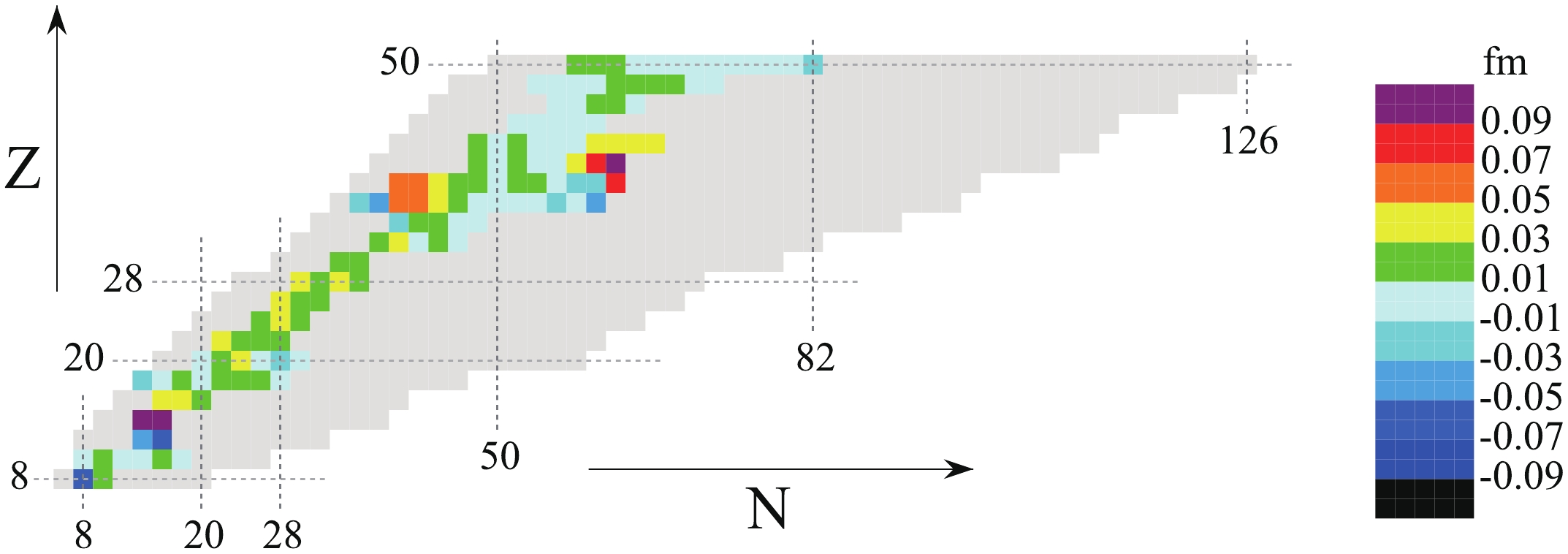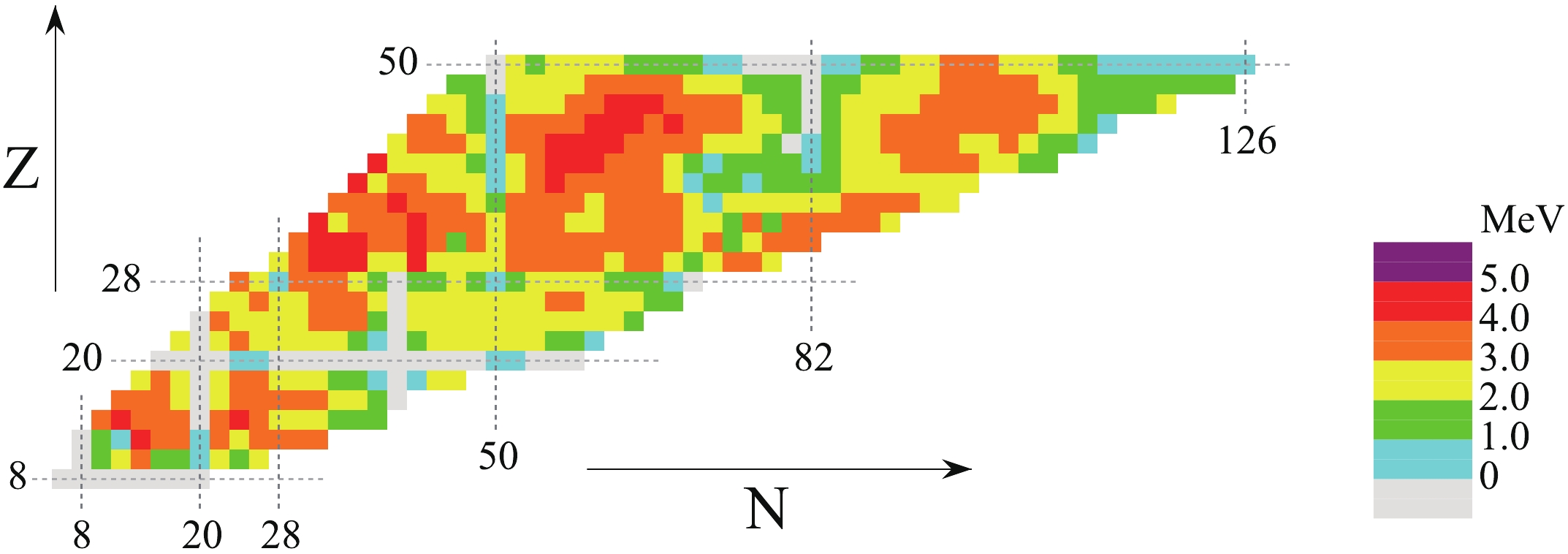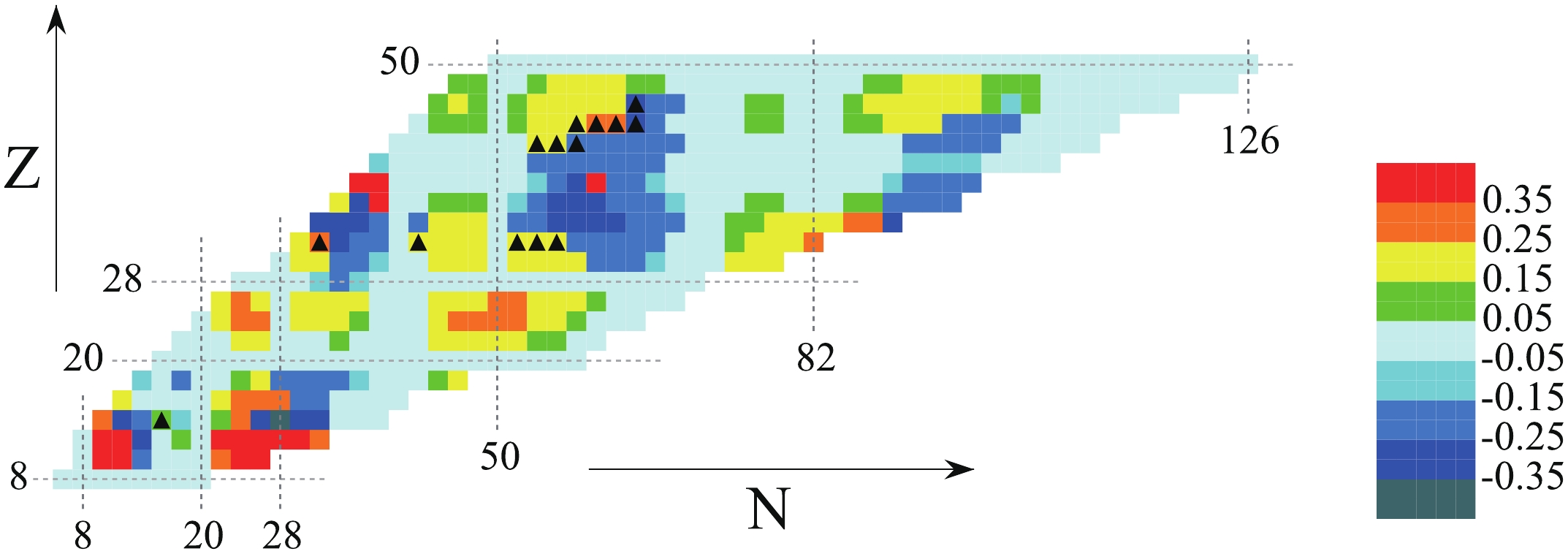HTML
--> --> -->During the past decades, various global nuclear models have been proposed to describe the nuclear mass, including the finite-range droplet model (FRDM) [5, 6], semi-empirical Weizs?cker-Skyrme (WS) model [7, 8], non-relativistic [9-12] and relativistic [13-17] density functional theories (DFTs). Nuclear DFTs start from the universal density functionals with a few parameters determined by fitting the properties of finite nuclei or nuclear matter. They can describe the nuclear masses and ground and excited state properties in a unified manner [18-20]. In particular, because of the consideration of the Lorentz symmetry, the relativistic or covariant density functional theory (CDFT) naturally includes the nucleonic spin degree of freedom and time-odd mean fields, which play an essential role in describing the moments of inertia for nuclear rotations [21-24]. Thus far, the CDFT has received considerable attention because of its successful description of many nuclear phenomena [18, 20, 25-29].
In the framework of CDFT, masses for over 7000 nuclei with
In Ref. [32], low-lying states of 1712 even-even nuclei from
The studies shown in Refs. [16, 17] demonstrate that the inclusion of DCEs can significantly improve the description of nuclear masses. Thus far, the inclusion of DCEs in the CDFT is still confined to nuclei with known mass, and the DCEs of most neutron-rich nuclei crucial in simulating the r-process are uninvestigated. Therefore, it is necessary to extend the investigation from nuclei with known mass to the boundary of nuclear landscape. Meanwhile, the pairing correlations were treated by the BCS approximation in Refs. [16, 17]. For the description of nuclei around the neutron drip line, this approximation is questionable because the continuum effect cannot be taken into account properly [37]. Nevertheless, the methods with the Bogoliubov transformation can provide a better description for the pairing correlations in weakly bound nuclei. Therefore, in the present study, the nuclear masses of even-even nuclei from O to Sn isotopes ranging from the proton drip line to the neutron drip line are performed within the triaxial RHB theory [38], and the beyond mean-field quadrupole DCEs are considered by the 5DCH method.
$ \hat{H}_{\rm{coll}}(\beta,\gamma) = \hat{T}_{\rm{vib}}(\beta,\gamma) + \hat{T}_{\rm{rot}}(\beta,\gamma,\Omega) + V_{\rm{coll}}(\beta,\gamma), $  | (1) |
$ \begin{split}{{\hat T}_{{\rm{vib}}}}(\beta ,\gamma ) \!=\!& -\! \frac{{{\hbar ^2}}}{{2\sqrt {\omega r} }}\!\!\left\{ \frac{1}{{{\beta ^4}}}\!\!\left[\frac{\partial }{{\partial \beta }}\!\!\sqrt {\frac{r}{\omega }} {\beta ^4}{B_{\gamma \gamma }}\frac{\partial }{{\partial \beta }}\! -\! \frac{\partial }{{\partial \beta }}\!\!\sqrt {\frac{r}{\omega }} {\beta ^3}{B_{\beta \gamma }}\frac{\partial }{{\partial \gamma }}\right]\right.\\& + \frac{1}{{\beta \sin 3\gamma }}\left[ - \frac{\partial }{{\partial \gamma }}\sqrt {\frac{r}{\omega }} \sin 3\gamma {B_{\beta \gamma }}\frac{\partial }{{\partial \beta }}\right. \\&\left.\left.+ \frac{1}{\beta }\frac{\partial }{{\partial \gamma }}\sqrt {\frac{r}{\omega }} \sin 3\gamma {B_{\beta \beta }}\frac{\partial }{{\partial \gamma }}\right]\right\} ,\end{split}$  | (2) |
$ \hat{T}_{\rm{rot}} = \frac{1}{2}\sum_{k = 1}^3\frac{\hat{J}^2_k}{{\cal I}_k}, $  | (3) |
In the framework of the CDFT-based 5DCH approach, all the collective parameters including the collective potential
Within the point-coupling CDFT, the unified and self-consistent treatment of mean fields and pairing correlations can be realized by solving the following RHB equation [39],
$ \left( {\begin{array}{*{20}{c}}{{{\hat h}_{\rm D}} - \lambda }&{\hat \Delta }\\{ - {{\hat \Delta }^ * }}&{ - {{\hat h}^ * } + \lambda }\end{array}} \right)\left( {\begin{array}{*{20}{c}}{{U_k}}\\{{V_k}}\end{array}} \right) = {E_k}\left( {\begin{array}{*{20}{c}}{{U_k}}\\{{V_k}}\end{array}} \right),$  | (4) |
$ \hat{h}_{\rm D} = -{\rm i}\mathit{{\alpha}}\cdotp\mathit{{\nabla}} + \beta(m+S) + V $  | (5) |
$ \begin{split}S =& {\alpha _S}{\rho _S} + {\beta _S}\rho _S^2 + {\gamma _S}\rho _S^3 + {\delta _S}\Delta {\rho _S},\\V =& {\alpha _V}{\rho _V} \!+\! {\gamma _V}{({\rho _V})^3} \!+\! {\delta _V}\Delta {\rho _V} \!+\! {\tau _3}{\alpha _{TV}}{\rho _{TV}} \!+\! {\tau _3}{\delta _{TV}}\Delta {\rho _{TV}} \!+\! e{A^0},\end{split}$  | (6) |
$ \begin{split}{\rho _S} = \sum\limits_{k > 0} {V_k^\dagger } {\gamma ^0}{V_k},\quad{\rho _V} = \sum\limits_{k > 0} {V_k^\dagger } {V_k},\quad{\rho _{TV}} = \sum\limits_{k > 0} {V_k^\dagger } \vec \tau {V_k},\end{split}$  | (7) |
$ \Delta_{ab} = \frac{1}{2}\sum_{cd}\langle ab|V^{pp}|cd\rangle_a\kappa_{cd}. $  | (8) |
By solving Eq. (4) iteratively, the total energy in the laboratory can be obtained,
$ \begin{split} E_{\rm{tot}} =& \int {\rm d}^3r\sum_{k>0}V^\dagger_k[\mathit{{\alpha}}\cdotp\mathit{{p}}+\beta m]V_k\\ &+ \int {\rm d}^3r\biggl\{\frac{1}{2}\alpha_S\rho_S^2+ \frac{1}{3}\beta_S\rho_S^3+\frac{1}{4}\gamma_S\rho^4_S+\frac{1}{2}\delta_S\rho_S\Delta\rho_S\\ &+\frac{1}{2}\alpha_V\rho_V^2+\frac{1}{2}\alpha_{TV}\rho_{TV}^2+\frac{1}{4}\gamma_V\rho_V^4+\frac{1}{2}\delta_V\rho_V\Delta\rho_V \\& +\frac{1}{2}\delta_{TV}\rho_{TV}\Delta\rho_{TV}\}.\end{split} $  | (9) |
$ \langle H\rangle + \sum_{\mu = 0}^2C_{2\mu}(\langle\hat{Q}_{2\mu}\rangle-q_{2\mu})^2, $  | (10) |
$ \hat{Q}_{20} = 2z^2-x^2-y^2,\quad \hat{Q}_{22} = x^2-y^2. $  | (11) |
 Figure1. (color online) Even-even nuclei from O to Sn isotopes predicted by the triaxial RHB approach with (panel (b)) and without (panel (a)) dynamical correlation energies. Discrepancies of the calculated binding energies with the data [4] are denoted by colors. The proton and neutron drip lines predicted by spherical RCHB (PC-PK1) [31], axial RHB (DD-PC1) [15], and axial RMF+BCS (TMA) [13] are also plotted for comparison.
Figure1. (color online) Even-even nuclei from O to Sn isotopes predicted by the triaxial RHB approach with (panel (b)) and without (panel (a)) dynamical correlation energies. Discrepancies of the calculated binding energies with the data [4] are denoted by colors. The proton and neutron drip lines predicted by spherical RCHB (PC-PK1) [31], axial RHB (DD-PC1) [15], and axial RMF+BCS (TMA) [13] are also plotted for comparison.In the triaxial RHB calculations without DCEs, it was found that the binding energies are systematically underestimated. Most deviations are in the range of
By including the DCEs, the underestimation of the binding energies is improved significantly, and the rms deviation is reduced from 2.50 MeV to 1.59 MeV. However, in the region
To estimate the number of bound nuclei from O to Sn isotopes, two-proton and two-neutron drip lines predicted by the present triaxial RHB approach with and without DCEs are also plotted in Fig. 1. The predicted number of bound even-even nuclei between the proton and neutron drip lines from O to Sn isotopes without DCEs is 569. The inclusion of DCEs has little influence on the proton and neutron drip lines, and the corresponding number of bound nuclei is 564. For comparison, the drip lines predicted by the spherical RCHB (PC-PK1) [31], axial RHB(DD-PC1) [15], and axial RMF+BCS(TMA) [13] are also shown. It is found that theoretical differences for the proton drip lines are rather small. However, the neutron drip lines predicted by different approaches differ considerably, and the differences increase with the mass number. The neutron drip line predicted by the triaxial RHB approach is located between those predicted by the axial RHB and spherical RCHB approaches.
Besides the binding energies, the charge radii calculated by the triaxial RHB were been compared with available data [60] in Fig. 2. The experimental charge radii are well reproduced, and most deviations between the calculated results and the data are in the range of
 Figure2. (color online) Charge radii of nuclei from O to Sn and their comparison with available data [60]. Discrepancies of the calculated charge radii with data are denoted by different colors.
Figure2. (color online) Charge radii of nuclei from O to Sn and their comparison with available data [60]. Discrepancies of the calculated charge radii with data are denoted by different colors.Figure 3 shows the contour map of the dynamical correlation energies
 Figure3. (color online) Contour map of the dynamical correlation energies Ecorr calculated by the 5DCH model based on triaxial RHB calculations as functions of neutron and proton numbers.
Figure3. (color online) Contour map of the dynamical correlation energies Ecorr calculated by the 5DCH model based on triaxial RHB calculations as functions of neutron and proton numbers.In Ref. [17], the binding energies of 575 even-even nuclei in the region of
The dynamical correlation energies
 Figure4. (color online) Dynamic correlation energies calculated by 5DCH based on triaxial RHB (circles) compared with those based on triaxial RMF+BCS [17] (triangles).
Figure4. (color online) Dynamic correlation energies calculated by 5DCH based on triaxial RHB (circles) compared with those based on triaxial RMF+BCS [17] (triangles).The contour map of the triaxial RHB calculated quadrupole deformation
 Figure5. (color online) Contour map of quadrupole deformation β calculated by the triaxial RHB approach as functions of the neutron and proton numbers. Nuclei with triaxial deformation are denoted by black triangles.
Figure5. (color online) Contour map of quadrupole deformation β calculated by the triaxial RHB approach as functions of the neutron and proton numbers. Nuclei with triaxial deformation are denoted by black triangles.The nuclei with triaxial deformation i.e.
The authors are grateful to Prof. ZhiPan Li and Prof. PengWei Zhao for providing the numerical computation codes and the fruitful discussions, as well as for the critical readings of our manuscript.

